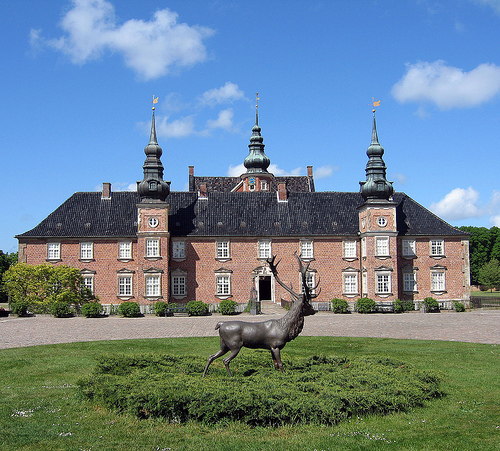

Location: Jægerspris, island of Zealand Map
Constructed: 13th century
Info: Jaegerspris Slot, Slotsgarden 20
Tel. 47 53 10 04
Open:Apr- Oct: 11am- 4pm Tue- Sun
Park: open daily
Jægerspris Castle is located in Jægerspris on the island of Zealand
in Denmark. You can get here from Danish Copenhagen by taking a
S-train to Frederikssund and then a bus 322 to the castle.
Construction of Jægerspris Castle began in the 13th century, but
little is preserved from the Medieval times. Jægerspris Castle lost
its military importance in the 16th and 17th centuries, but unlike
other military fortification of the time it was reconstructed to
serve as a hunting lodge. The castle changed its original name of
Abrahamstrup was switched to Jægerspris Castle that literally means
Hunter's Praise Castle.
In 1850's it became a private
retreat for Danish king King Frederik VII and his wife Countess
Danner. The marriage caused lots of controversy since it was a
morganatic or an union between two people of unequal social status.
Countess Danner was a ballet dancer and a singer before she was a
spouse of a monarch earning a public scolding and hate. Eventually
she transformed Jægerspris Castle into a asylum for women and found
an organization of Frederick VII's Foundation for Poor Women from
the Working Class. This earned this chateau another name of Donner's
house.
The park around Jægerspris Castle is just as famous
at the estate itself. The most famous tree on its ground is
Kongeegen or The Royal Oak. It is the oldest tree in Northern Europe
at its age of approximately 2000 years.
History
Until 1677 the castle was called
Abrahamstrup. Who this Abraham is is not known. However, it is
speculated that the name is derived from Valdemar Sejr's son Abel.
In the 13th century, most of Horns Herred belonged to Valdemar
Sejr's crown estate.
In the period 1673, the castle came into
private ownership with master hunter Vincent Hahn. It was in 1677
under his ownership that the castle got its current name, Jægerspris
Castle.
In 1679, the castle was transferred again to the
royal house, where it was converted into a summer residence for
Frederik IV.
In 1703 the king left the castle to his brother
Prince Carl.
In 1729, Crown Prince Christian (VI) took over
the castle after Prince Carl's death.
In 1743, Crown Prince
Frederik (V) inherited the castle, which was inherited until King
Frederik VII, who became the last royal owner of the castle. At the
end of the monarchy in 1848, the castle passed to the state.
In 1854, however, the king repurchased the castle for use as a
refuge from the upper bourgeoisie and the aristocracy's indignation
at his bourgeois marriage to Louise Christine Rasmussen (better
known as Countess Danner).
After the king's death in 1863,
Countess Danner inherited the castle and had it as her permanent
residence. In 1867 she established an orphanage in the former
cavalry wing. Almost half a year before her death, she founded the
foundation King Frederik VII's Foundation of 30 October 1873. The
foundation included, among other things, that Jægerspris Castle,
after the countess's death, was to be converted into an orphanage
for poor and disadvantaged girls.
In the castle park you can
see Countess Danner's marble coffin, which is located in a burial
mound, which is open at the side. Here is also Danneregen, which is
a graft of Denmark's oldest tree, Kongeegen.
The Danish porn
comedy In the Sign of the Bull (1974) takes place around Jægerspris
Castle, where the count's death turns the local community upside
down.
For a number of years, the castle housed Jægerspris
Socialpædagogiske Seminarium, Dannerseminariet, which in 2009 was
merged with Hillerød Pædagogseminarium.
There are still
(2013) orphanages at Jægerspris Castle, as well as other social
treatment offers. Jægerspris Castle Estate is on 3,010 hectares with
the farms Christiansminde, Egelundsgården and Louiseholm.